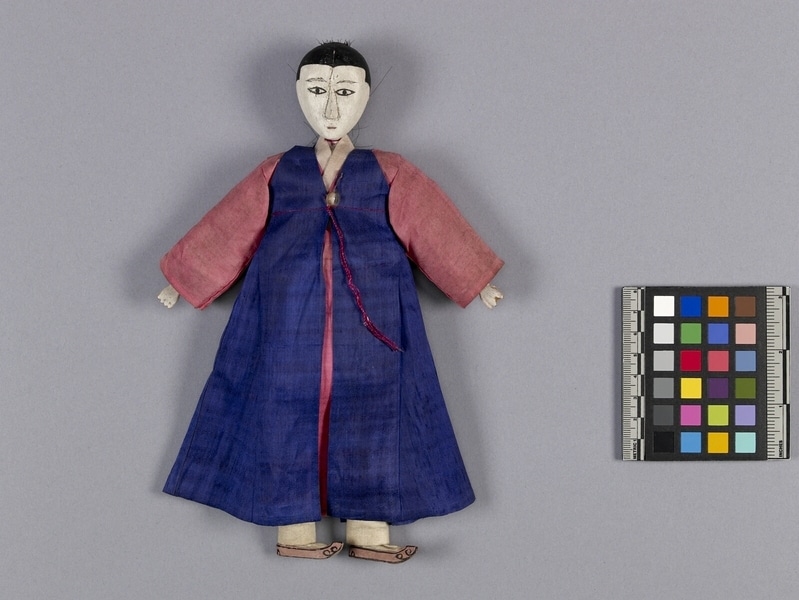Doll Item Number: N3.63 from the MOA: University of British Columbia


Description
Doll figure carved out of wood with articulated shoulders and ankles. The face and hands are painted white, with the eyes and eyebrows painted in black, and the mouth painted in pink. The hair is painted black on the crown of the head with a braid of stiff black hair attached to the back of the head. The hair is braided with a strip of blue-green silk, and the braid is tied at the top with a band of burgundy silk doubled over so that there are no raw edges. The figure is dressed in a pink long-sleeved silk robe with a white neckband, over which is a long gored blue silk vest fastened with a single round glass button and secured with a burgundy silk cord at underarm height. The figure wears pink shoes with black ornamentation, white leg wrappers, and long white underpants with a white loincloth, above which is a short white under-jacket.
History Of Use
Doll is a member of a family of dolls (see N3.60 a-b, N3.61, N3.62 and N3.64). It is likely that this set of dolls was custom-made for presentation to foreigners. They show typical Korean clothes, which were made with accurate detail of form, material, and technique for these dolls. Clothing and hairstyles of this type were worn by unmarried teenaged boys of the official class. Such clothing was for everyday use. It includes an inner short jacket of fine cotton called “chogori”, cotton under-trousers “paji”, a silk coat without a slit “doo-ru-magi”, and long silk vest with pleats under the arms for ease of movement. The underarm tie, called “jo-dae”, was for formal wear. Before the late Chosun period the coat had a slit at the back and wider sleeves. Young men wore black or purple hair ribbons. They also wore hats called “bok-gun” with a panel extending down the back below the shoulders, created by tying black cloth. Their under-trousers were more narrow than those worn by men, as boys were more active. Shoes of this shape and with this ornamentation, made of dyed leather, were the same as those worn by high-class men, and were called “tae-sa-hae”. At this time, boys were married by the time they were 15-16 years old.
Iconographic Meaning
Doll represents the teenage son in the family of dolls. The clothing material and style indicate that the doll was part of the yangban class, the highest social class during the late Chonson Dynasty. His braid indicates that he is not yet married; if he were married, it would be in a topknot.
Item History
- Made in Korea between 1800 and 1910
- Collected between 1899 and 1939
- Owned by Marion Stephan before August 1964
- Received from Marion Stephan (Donor) during August 1964
What
- Name
- Doll
- Identification Number
- N3.63
- Type of Item
- doll
- Material
- wood, paint, silk fibre, glass, cotton fibre, dye, horse hair ?, paper and paste adhesive
- Manufacturing Technique
- cut, carved, smoothed, painted, spun, woven, dyed, sewn, pasted, twisted, braided and tied
- Overall
- height 24.0 cm, width 16.0 cm, depth 3.0 cm
Who
- Culture
- Korean
- Previous Owner
- Marion Stephan
- Received from
- Marion Stephan (Donor)
Where
- Holding Institution
- MOA: University of British Columbia
- Made in
- Korea
When
- Creation Date
- between 1800 and 1910
- Collection Date
- between 1899 and 1939
- Ownership Date
- before August 1964
- Acquisition Date
- during August 1964
Other
- Item Classes
- textiles
- Condition
- good
- Current Location
- Case 77
- Accession Number
- 0113/0062